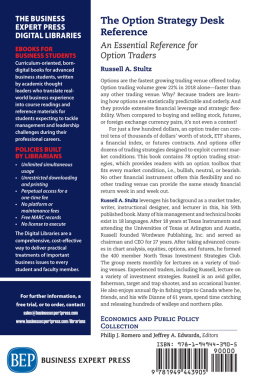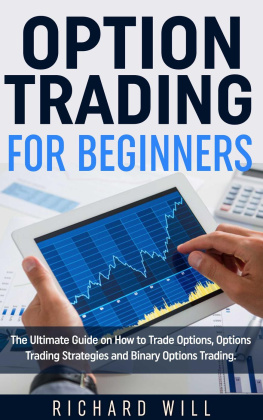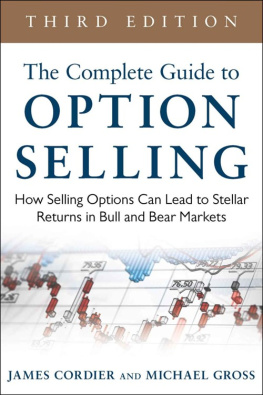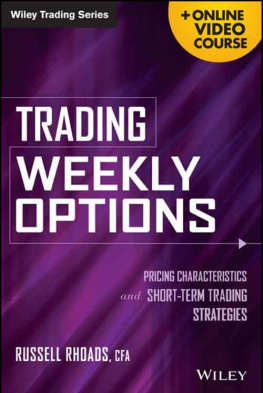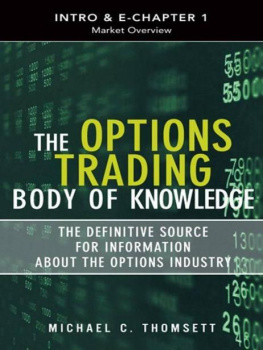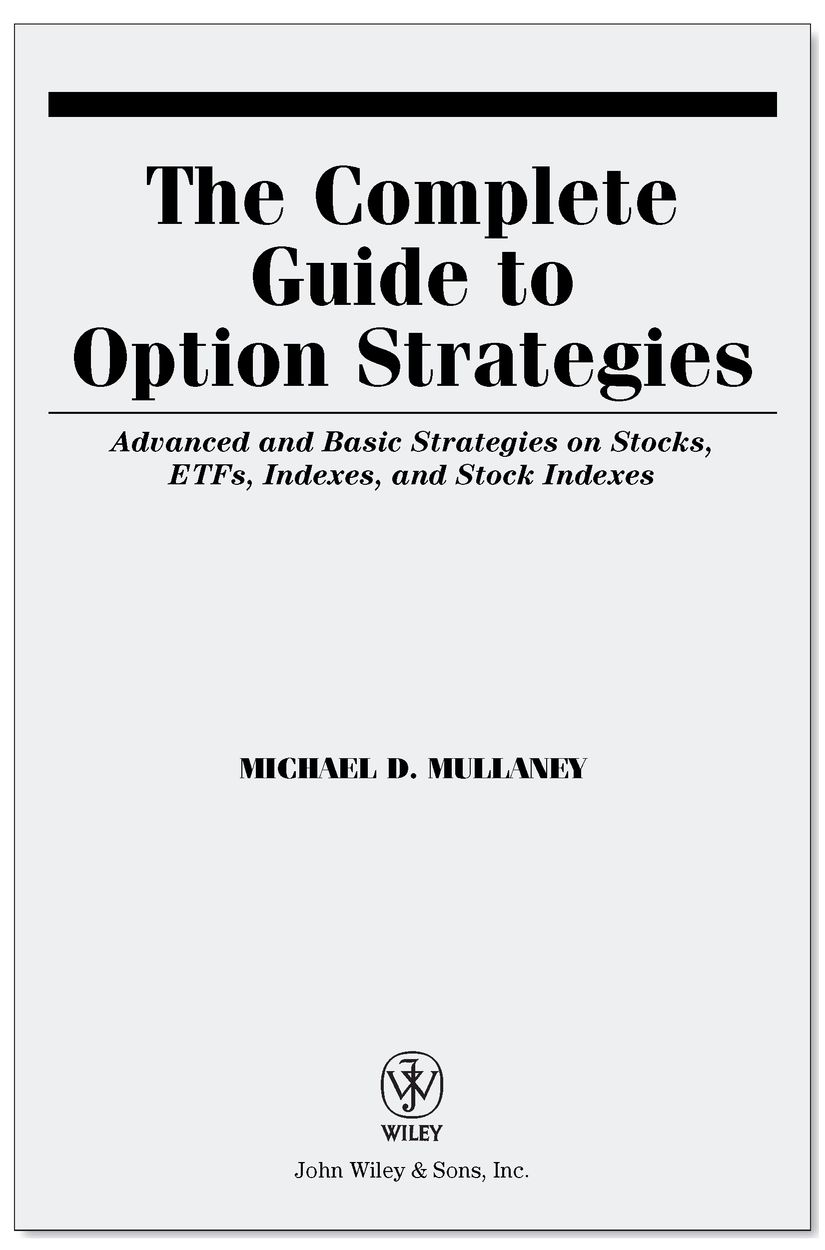Table of Contents
Founded in 1807, John Wiley & Sons is the oldest independent publishing company in the United States. With offices in North America, Europe, Australia, and Asia, Wiley is globally committed to developing and marketing print and electronic products and services for our customers professional and personal knowledge and understanding.
The Wiley Trading series features books by traders who have survived the markets ever-changing temperament and have prosperedsome by reinventing systems, others by getting back to basics. Whether a novice trader, professional, or somewhere in between, these books will provide the advice and strategies needed to prosper today and well into the future.
For a list of available titles, please visit our web site, www.WileyFinance.com.
To my wife, Sue, for her support, encouragement,
and guidance along the way.
To my daughter, Melissa, who has always made me proud and
continues to do so as she pursues her dream of becoming a
physician at Florida State Universitys medical school.
To my daughter, Michele, who is attending Emory University
and who always amazes me with her passion and
determination to excel.
Preface
Why should you read a book on options? Rapid and severe declines in the stock market demonstrate that the buy and hold method of investing has a lot of risk and that traders need a different vehicle to control risk. Individuals who recognize and embrace the shift to a traders market have the best chance to prosper, and the best trading vehicle available is options. Options can help you in volatile and unpredictable markets by enabling you to profit in numerous ways.
Options are probably the most versatile trading tool today. No other investment vehicle seems to have such a unique set of characteristics and flexibility. Options have become a popular tool for individuals and, fortunately, you do not have to work on the floor of an exchange to understand options. Trading options can empower an individual trader to move quickly in comparison to institutions, which must stay invested at all times with large and diversified portfolios.
Your chances of success increase if you have a game plan, establish goals, and understand how options move. Focusing on becoming a better trader to make money should be the main purpose of reading a book on options. I realize that a book on options can also be read for the enjoyment of learning the theory, mathematical applications, and technical jargon. (Who would not enjoy learning about the assumptions underlying options?) There is nothing wrong with tackling the intellectual challenges associated with learning, but our time is valuable, and it is more important to stay focused on how to become a better trader.
The Complete Guide to Option Strategies is intended to describe option principles in an understandable manner by starting with the basics, then moving up the educational ladder to the intermediate level, and finally to an advanced level. This book provides the tools that will allow you to prosper in many market conditions and enable you to trade options not only on stocks but also on exchange-traded funds (ETFs), stock indexes, and stock index futures. The content of these pages describes the option buying and selling strategies that you should know and would most likely be interested in using.
This book addresses simple and complex strategies by using hundreds of examples, tables, and graphs. Some option strategies are known to be difficult, but the examples, tables, and graphs add great clarity; as they say, a picture is worth a thousand words. The presentation means you have a comprehensive and step-by-step analysis of each strategy. The consistency of the examples is designed to make it easy for you to compare one strategy with another. I even decided to include a chapter on option terminology to provide a framework with which you can view options so you can quickly analyze any option position at a glance.
A separate chapter is devoted to every main strategy. This book avoids shortcuts when describing strategies so it gives you full and complete understanding. As much as possible, each chapter stands on its own. Occasionally, of course, you may want to flip back and forth between chapters. This approach is intended to help you gain a thorough understanding of option strategies and make the book easier to follow. As a result of this approach, you will notice some repetition; however, this is intentional because it should help reinforce your knowledge of strategies and principles. The book uses similar language to describe variations of the same strategy, again, to make it easier to follow. The overall approach is to first show how a strategy can be executed from the approach of buying calls, then buying puts, followed by selling calls, and then selling puts. The typical strategy, therefore, approaches the strategy from four different perspectives.
Each strategy chapter (Chapters 7 to 22) is organized in a similar manner to make the chapters easier to read and to ease comparisons of one strategy with another. Chapters typically include opening remarks, an overview, a description of each variation of the strategy, and a comprehensive example of each strategy. After strategy examples, each chapter includes a section called Beyond the Basics and concludes with a section called Final Thoughts.
HOW TO USE THIS BOOK
The Complete Guide to Option Strategies is intended to be a reference book, although it also can be read from cover to cover. If you are very familiar with basic concepts, you can simply skip chapters and go directly to the discussion that you are looking for.
The book begins with the basics and, in the process, describes hundreds of options terms, most accompanied by an example. It then covers more fundamentals, such as option pricing, the Greeks, buying versus selling, and terminology.
It takes the approach that basic option strategies can be broken down into buying a call, buying a put, selling a call, and selling a put. Once you understand this framework, you should be able to comprehend any option strategy at a glance. A separate chapter is devoted to each of the four basic option strategies before moving forward to more complex strategies in later chapters. Each basic strategy is analyzed from different perspectives; for example, the chapter on a call option provides a description of the strategy and comprehensive examples at strike prices of 90, 95, 100, 105, and 110. Likewise, the chapter on a put option provides a description of the strategy and comprehensive examples at the same strike prices. Spread strategies are covered in later chapters. After considering the different variations in strategies, this book covers hundreds of option strategies.
After the strategy chapters, a comparison of options on stocks, ETFs, stock indexes, and stock index futures is presented. The final part of the book covers advanced topics, such as volatility, exercise and assignment, risk management, margin, and taxes. The Complete Guide to Option Strategies is divided into the following five parts:
Part One: Learning the Fundamentals
Chapters 1 to 6 describe option basics in depth. Part One includes Chapter 1, Getting Ready to Trade; Chapter 2, Option Fundamentals; Chapter 3, What Determines an Options Price?; Chapter 4, Tools of the TradeGreeks; Chapter 5, Buying versus Selling; and Chapter 6, Understanding Spread Terminology.


